To help you get it right, I turned to someone who’s been deep in the trenches of localization: Erik Sarissky, Head of International Marketing and Product Localization at Ahrefs.
Erik has quadrupled organic traffic to Ahrefs’ Spanish blog in 18 months, going from 5.4k visits to over 22k visits. In addition to international marketing activities, he oversees localization efforts across 14 languages and constantly evaluates new possible languages.
One of his most eye-opening wins? After switching from Continental Portuguese to Brazilian Portuguese, Ahrefs saw an explosion in traffic to its local content and landing pages.

So I asked Erik if he’d be willing to share how he did it—and what he’s learned along the way.
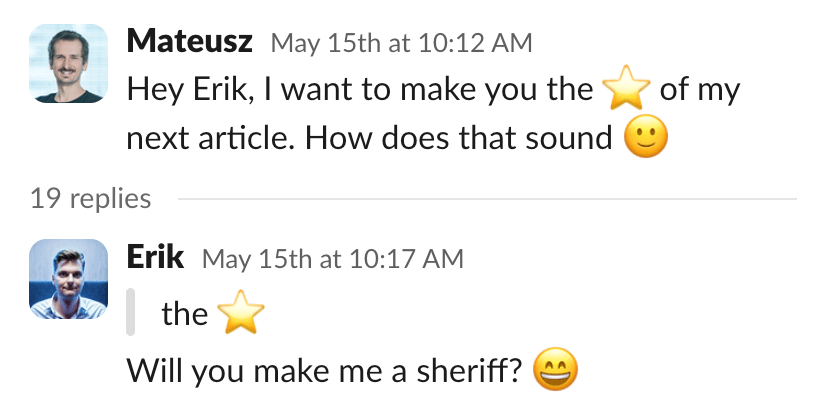
Whether you’re considering expanding into neighboring markets or exploring growth far away, this guide breaks down what actually moves the needle in localization SEO and what’s just noise.
Translation is a step. Localization is a system. Let’s break it down.
- Translation is about converting words from one language to another, preserving meaning and structure. Think of it like Google Translate, but done by a human. It’s accurate, but literal.
- Localization adapts examples, references, idioms, visuals, and even the strategy to feel natural in the target market. It’s the difference between being a tourist who memorized a phrasebook and someone who actually grew up there.
- Transcreation takes things further. It adapts the tone, emotion, and intent of a message so it hits home in a different culture. A clever English tagline might need completely different wording to feel clever in Spanish. It’s less about fidelity, more about resonance.
In SEO, this difference matters. You’re not just translating copy—you’re aligning with how people search, what they care about, and the problems they’re trying to solve.
“We already had good content in English,” Erik told me, “but there was no clear strategy. We were just translating everything without considering localization or keyword research. I knew that by fixing this, traffic would grow.”
And it did. That’s why a translation-only approach often falls flat. It misses the nuance, and with it, the traffic.
We need to start with a wake-up call: localization is no longer optional, because Google might do it for you.
Since early 2025, Google has been increasingly translating English content into local languages and serving it under a Google-owned subdomain (e.g., translate.google.com). This proxy translation shows up in AI Overviews, Featured Snippets, and even the regular 10 blue links.
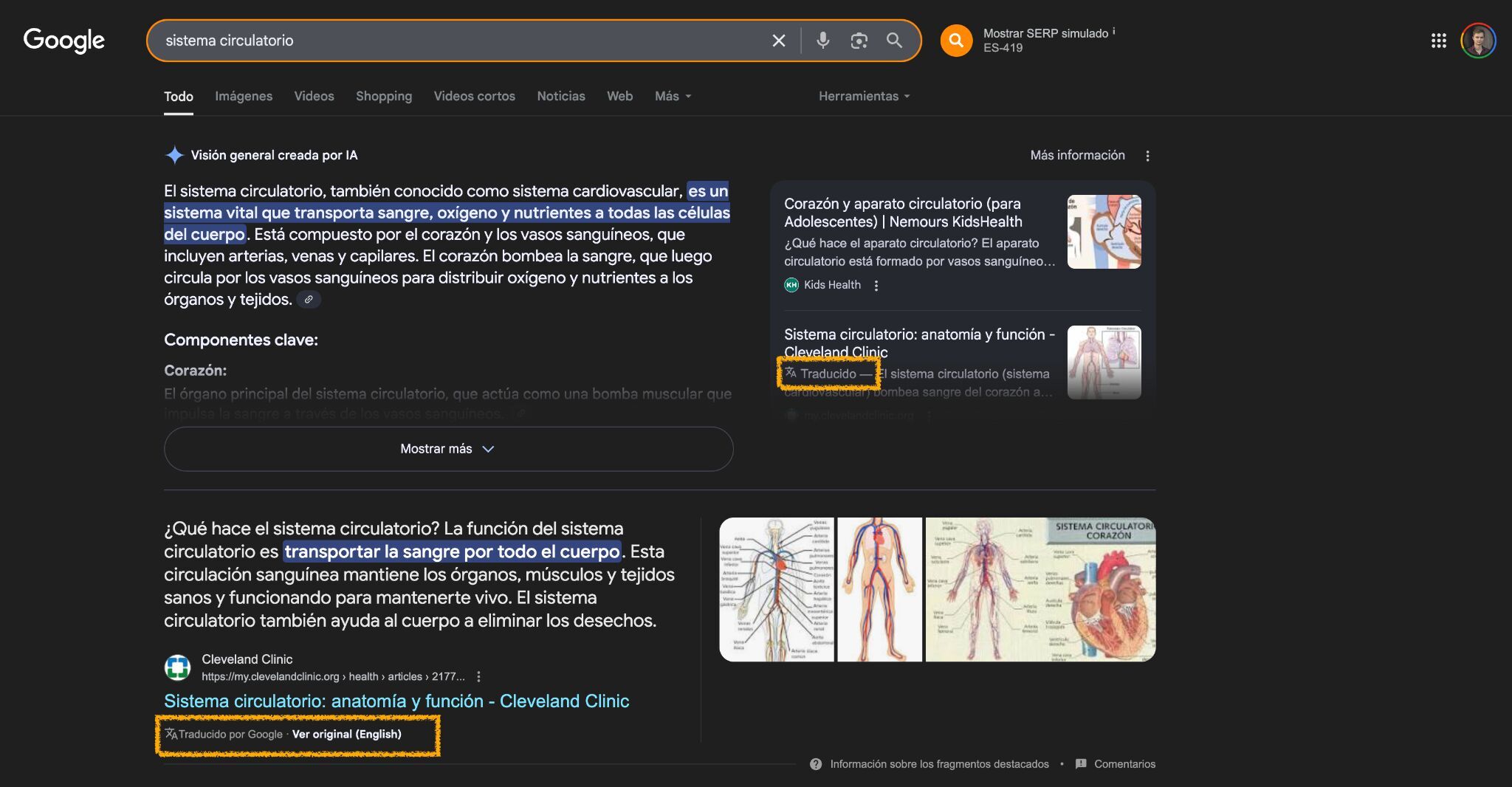
The result? Users never land on your website. Instead, they view a Google-hosted version of your content, and any clicks or link equity are attributed to Google, not you.
“If you don’t localize your content, Google might do it for you—and take the traffic.”
If you want to see if Google is auto-translating your website pages, you can use Search Console and Ahrefs to find out:
In Google Search Console, go to Search Appearance → Translated Pages.
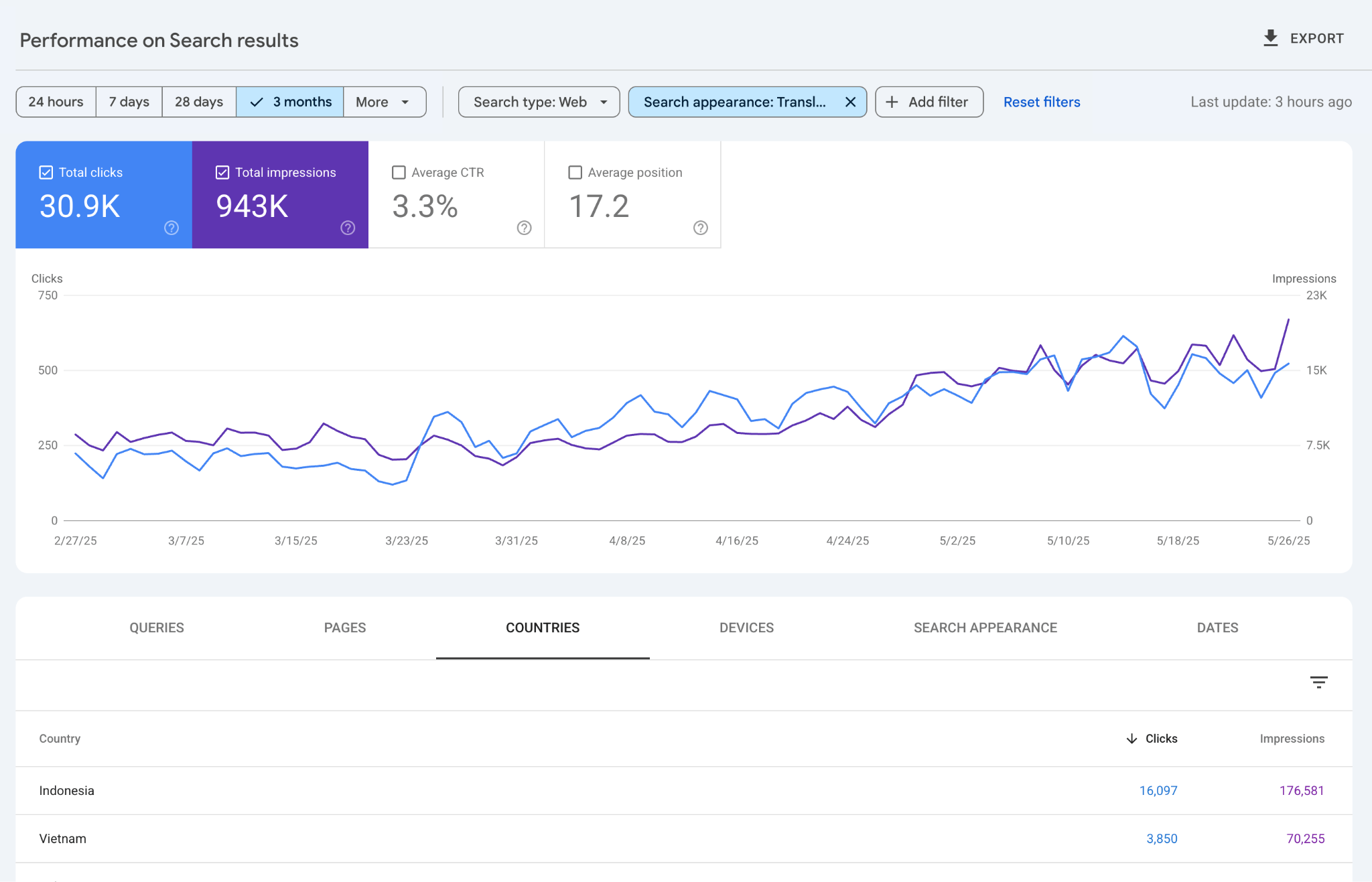
In Ahrefs’ Site Explorer, open the top pages report for translate.google.com and apply a “URL contains” filter, entering your domain name.
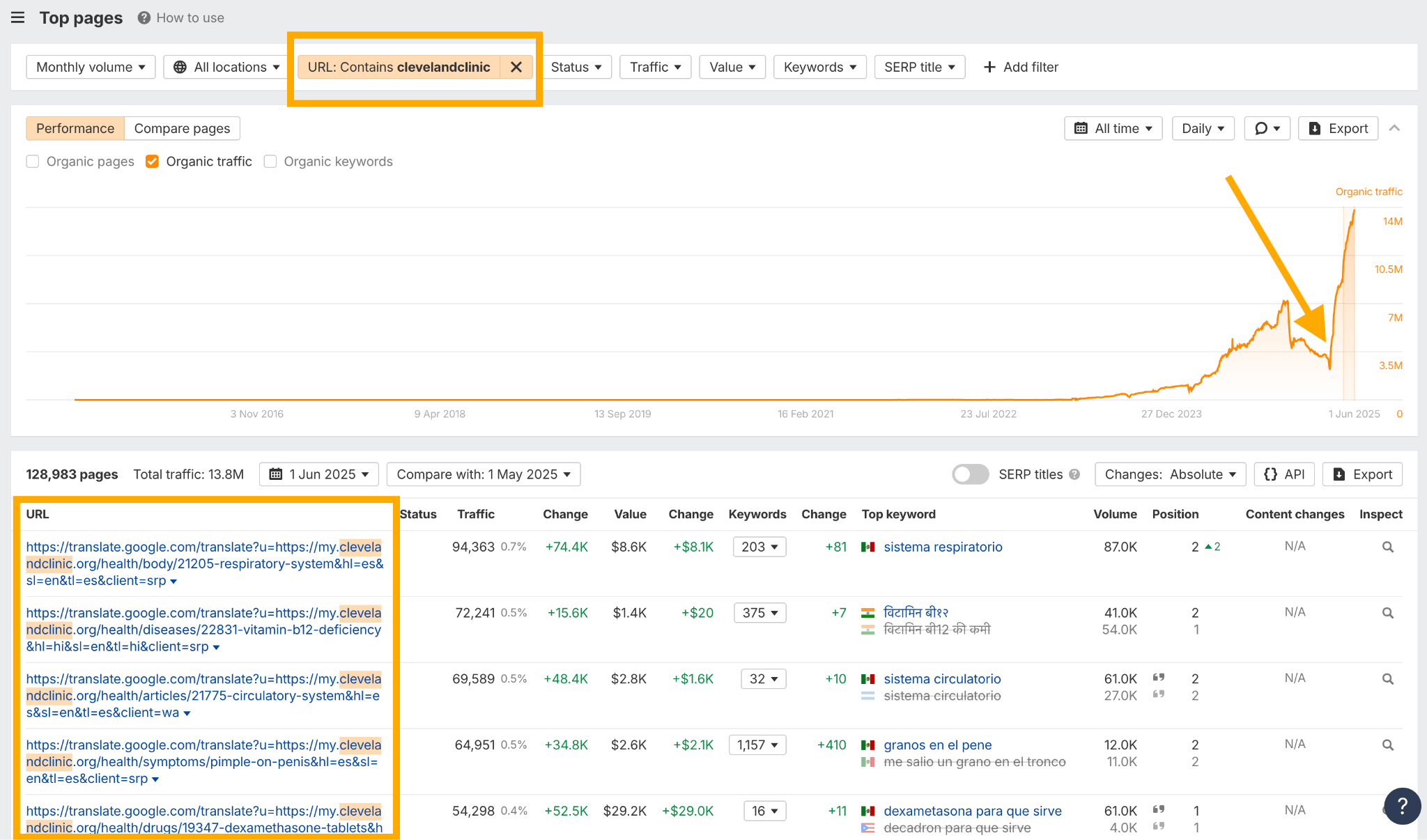
The fix? Localize your content—even minimally. A 300-word native-language version can often be enough to replace Google’s proxy page in the SERPs.
Trying to localize for everyone at once is a recipe for burnout. Instead, do what Erik did: choose markets based on metrics.
“We base decisions on billing, interface language use, brand searches, GDP, and tech adoption. Indonesia surprised us—it’s one of the best in terms of billing.”
Spanish was the pilot. We’ve been quite active in Spanish-speaking countries, organizing all sorts of meetups and taking part in conferences in Spain and Latin America.

Then, Japan because we were already quite popular there (more popular than our competitors, if I’m not mistaken). Indonesia emerged as an unexpected champion, so it’s going to be next in line. When you let data lead, you invest smarter and grow faster.
Look at historical demand and potential future upside. Markets with fast-growing tech ecosystems or changing search behavior (like South Korea’s move from Naver to Google) may be more ripe than they seem.
That brings us to local keyword research.
What works in English won’t always work in Spanish, Japanese, or German. Localized SEO starts with local intent.
“We check traffic potential, business potential, and assign priorities. Then we decide if it’s worth adapting or writing from scratch.”
Here’s what Erik’s referring to.
In Ahrefs’ Keywords Explorer, you can check traffic potential individually for over 200 countries. By the way, traffic potential is the total amount of organic traffic that the #1 ranking page for your target keyword gets from all the keywords it ranks for.
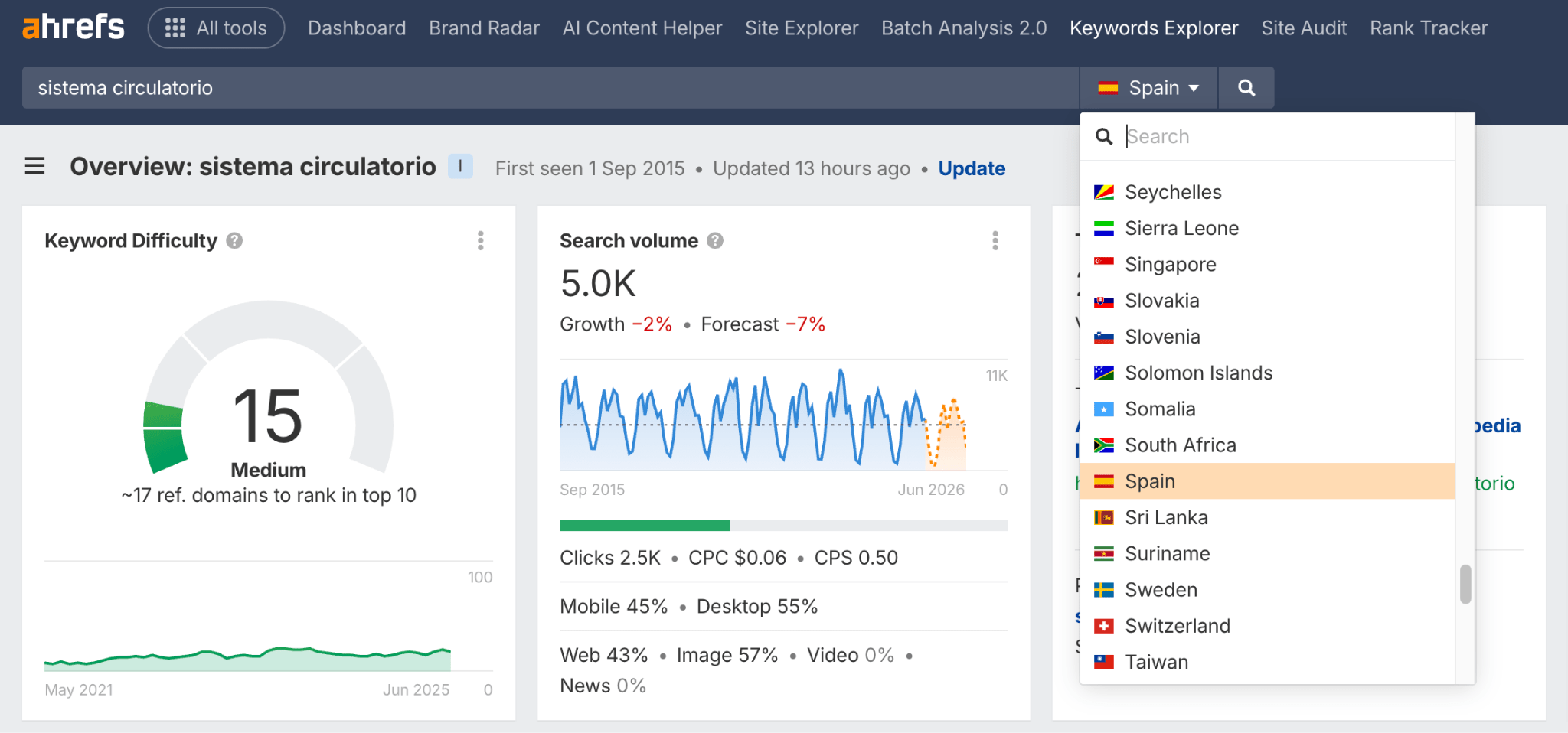
If you skip this step, you risk optimizing for keywords no one searches—or worse, competing on terms you can’t win.
To make things easier, you can start with your native language, add keywords to a list, and let AI show relevant translations with SEO metrics right inside the tool.

Here’s a sample result that instantly dispels doubts about the correct translation.
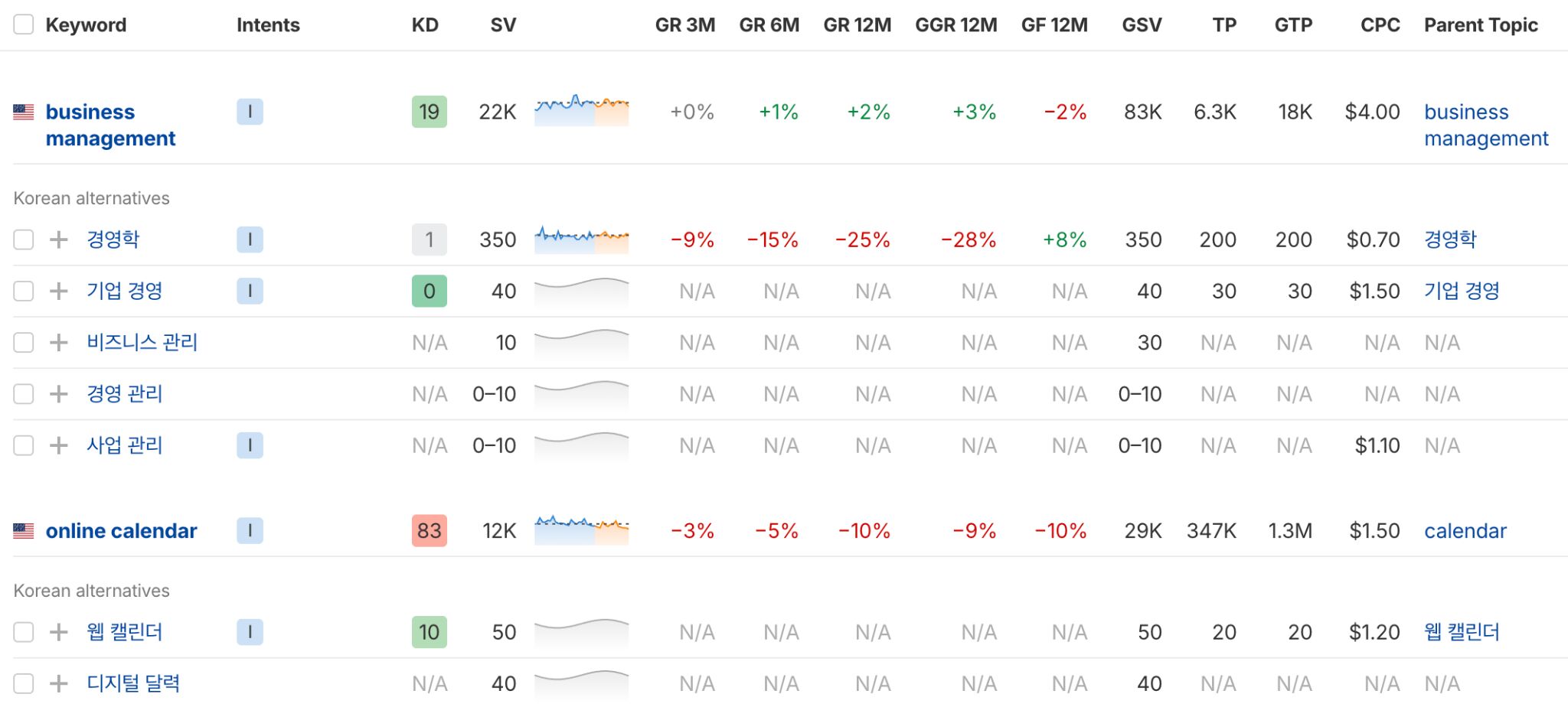
Next, Erik uses Ahrefs’ business potential framework to prioritize keywords. We score every marketing idea from 0 to 3 based on how essential our product is to the problem.
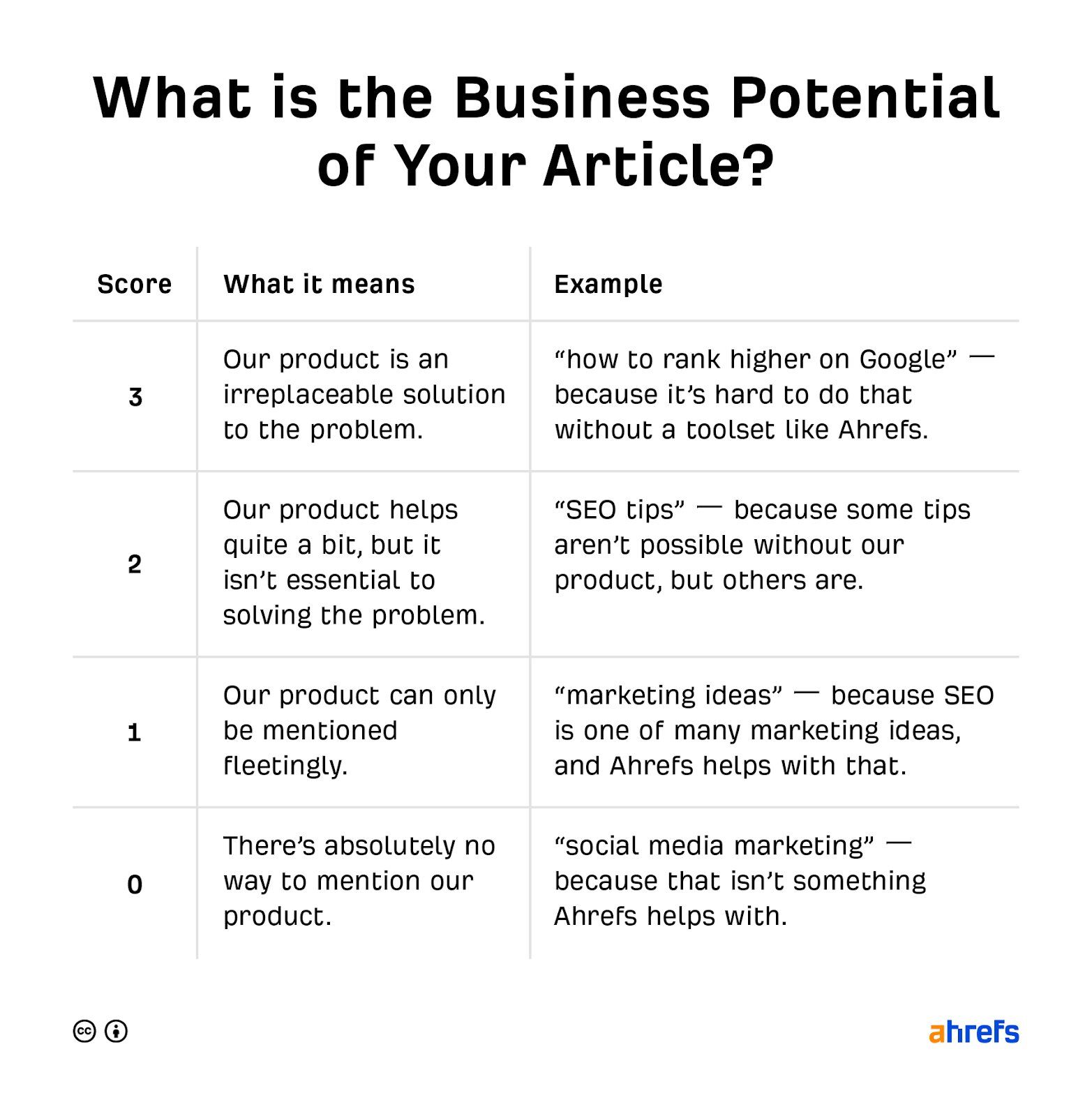
“If you’re just translating everything, you’re wasting time,” Erisk told me bluntly. The smarter approach is to choose what deserves translation and identify when creating from scratch is a better investment.
For example, Erik’s team begins by translating data studies directly, as this is the most efficient method. They then create supplementary micro-studies within these translated pieces to add local relevance.
“We created a workflow to review which articles to translate and when to write new ones. Sometimes translations don’t make too much sense—it’s better to write 100% new articles based on local keyword research.”
Before you even start localizing, step back and map your goals. Consider content age, market relevance, and search demand. Prioritize pieces that will perform, not just the ones you’ve recently published.
A good starting point would to look at the traffic and links a piece of content gets. Just plug in the URL of the page in Ahrefs’ Site Explorer and look at these numbers in the Overview report.
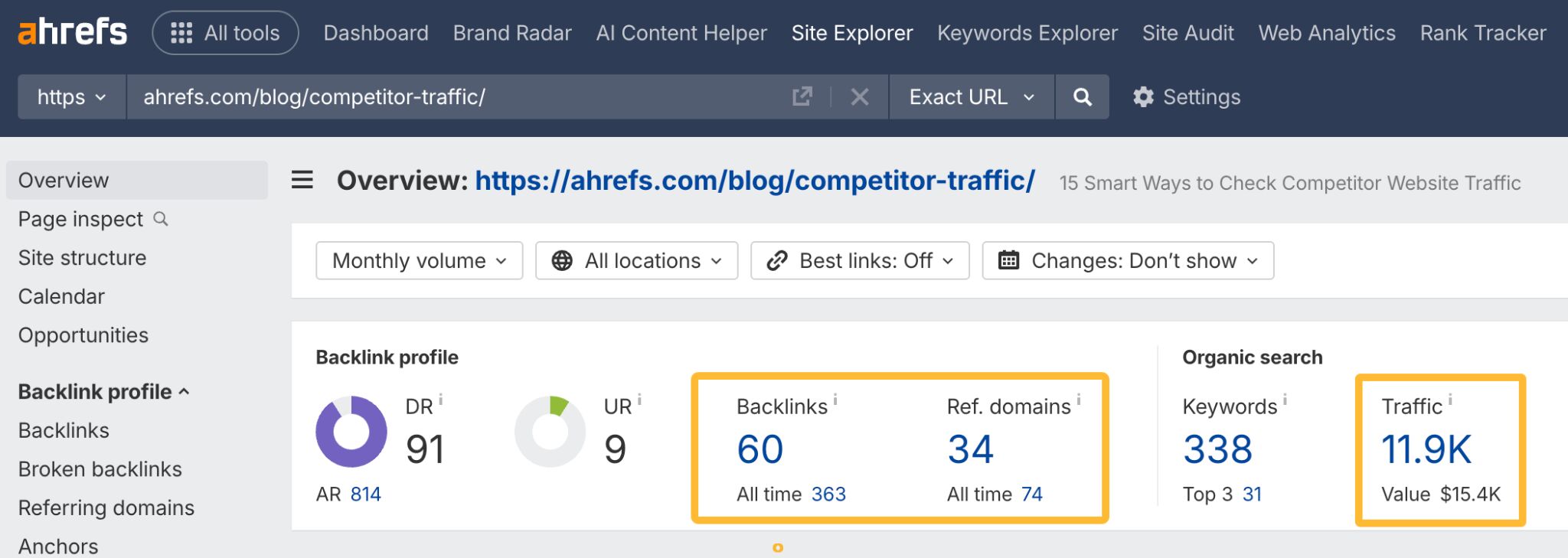
To see which pages perform the best, head on to the Top pages (you can additionally filter by country) and Best by link report.
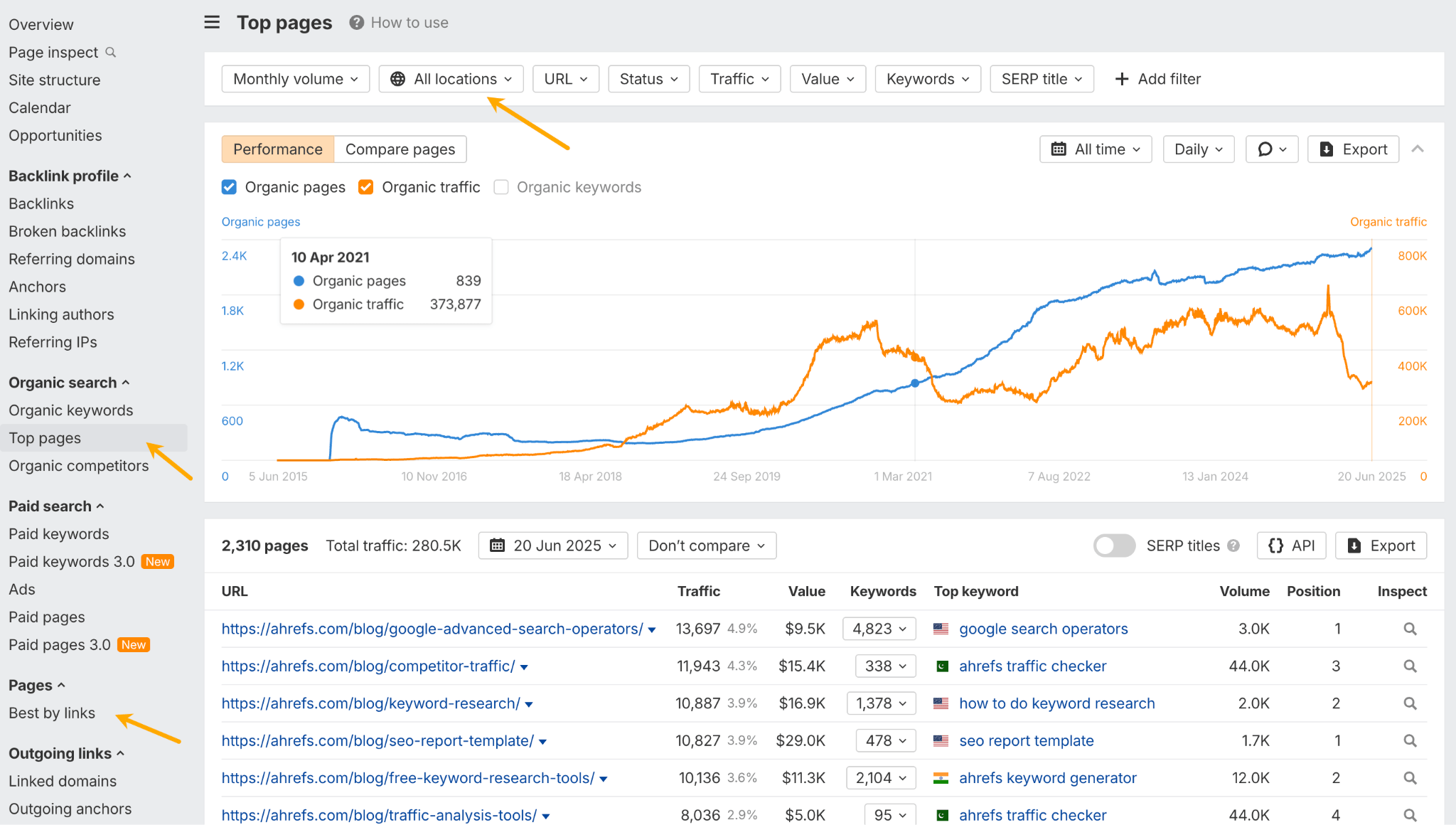
If your localized content reads like a clumsy translation, it won’t connect. To truly resonate, it needs to feel like it was written by someone who lives in that market.
“When I took over the Spanish blog, we started using more examples from the Spanish market and created our own case studies.”
So, the advice here is: use local case studies, adapt examples to fit regional norms, and reference the platforms your audience actually uses.
Here’s Erik showing the results of localizing a guide to affiliate marketing by using local examples:
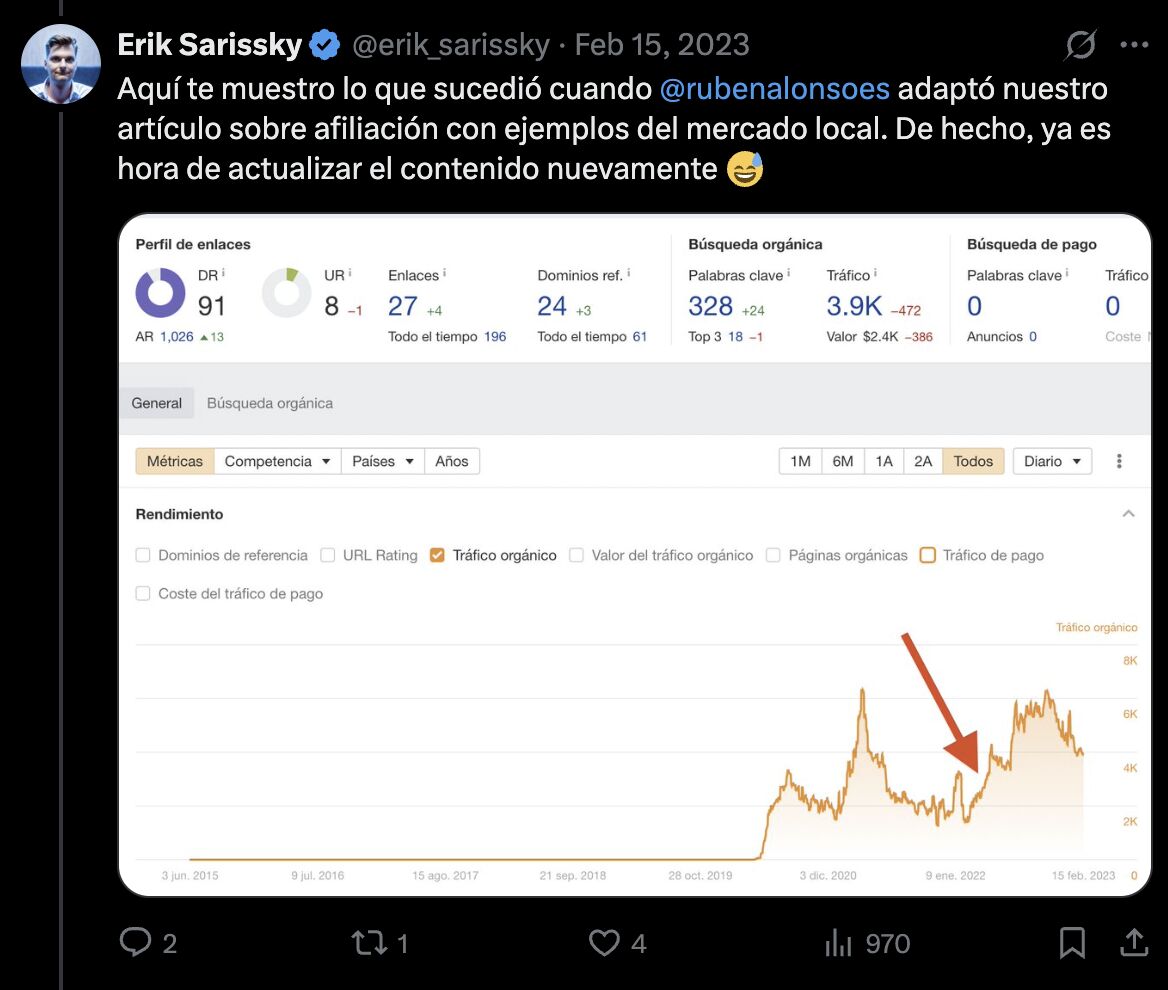
And this is an example of how they created an entirely new article about marketing book recommendations by asking Spanish speakers for their favorites, rather than simply translating the existing English version.
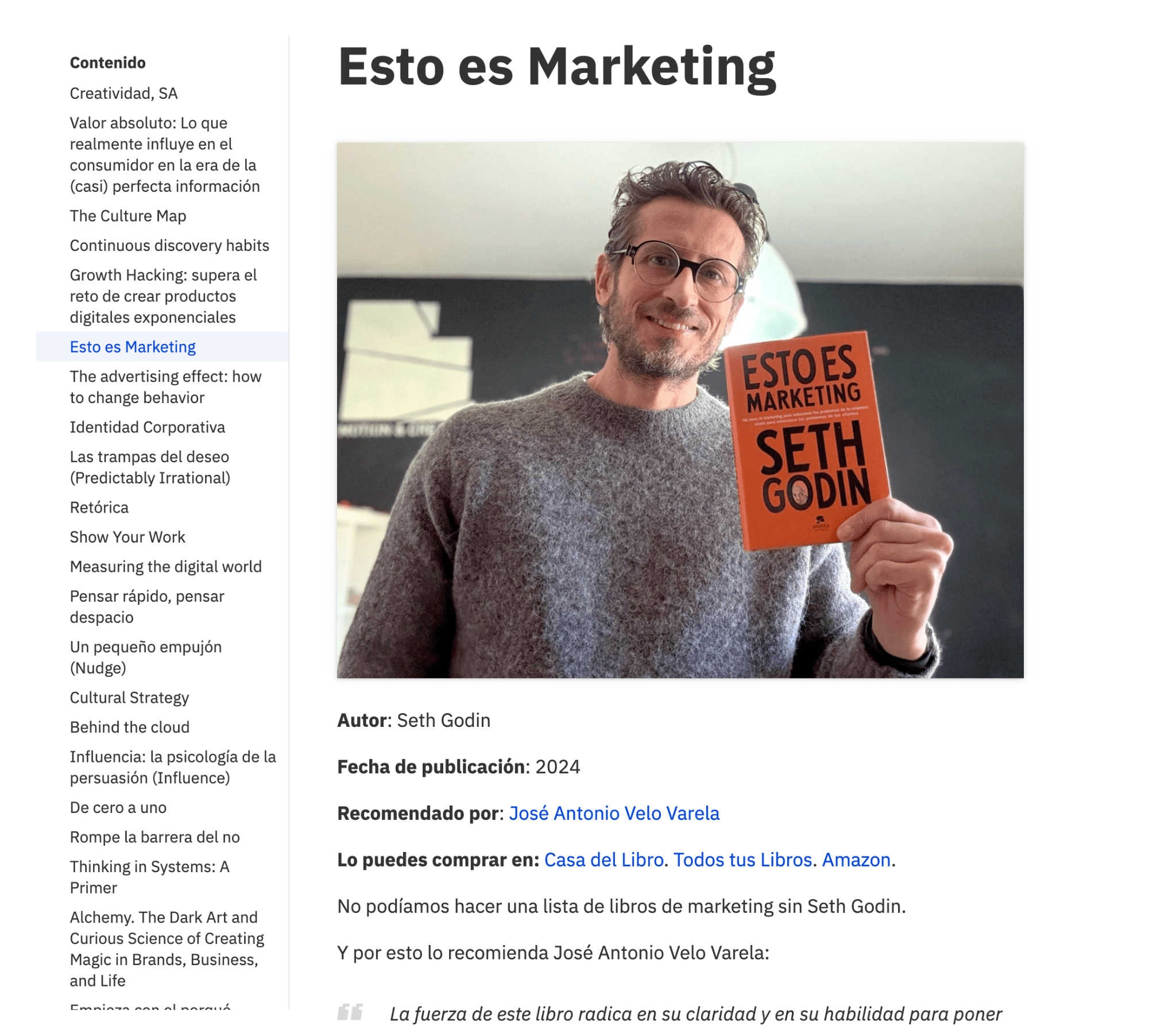
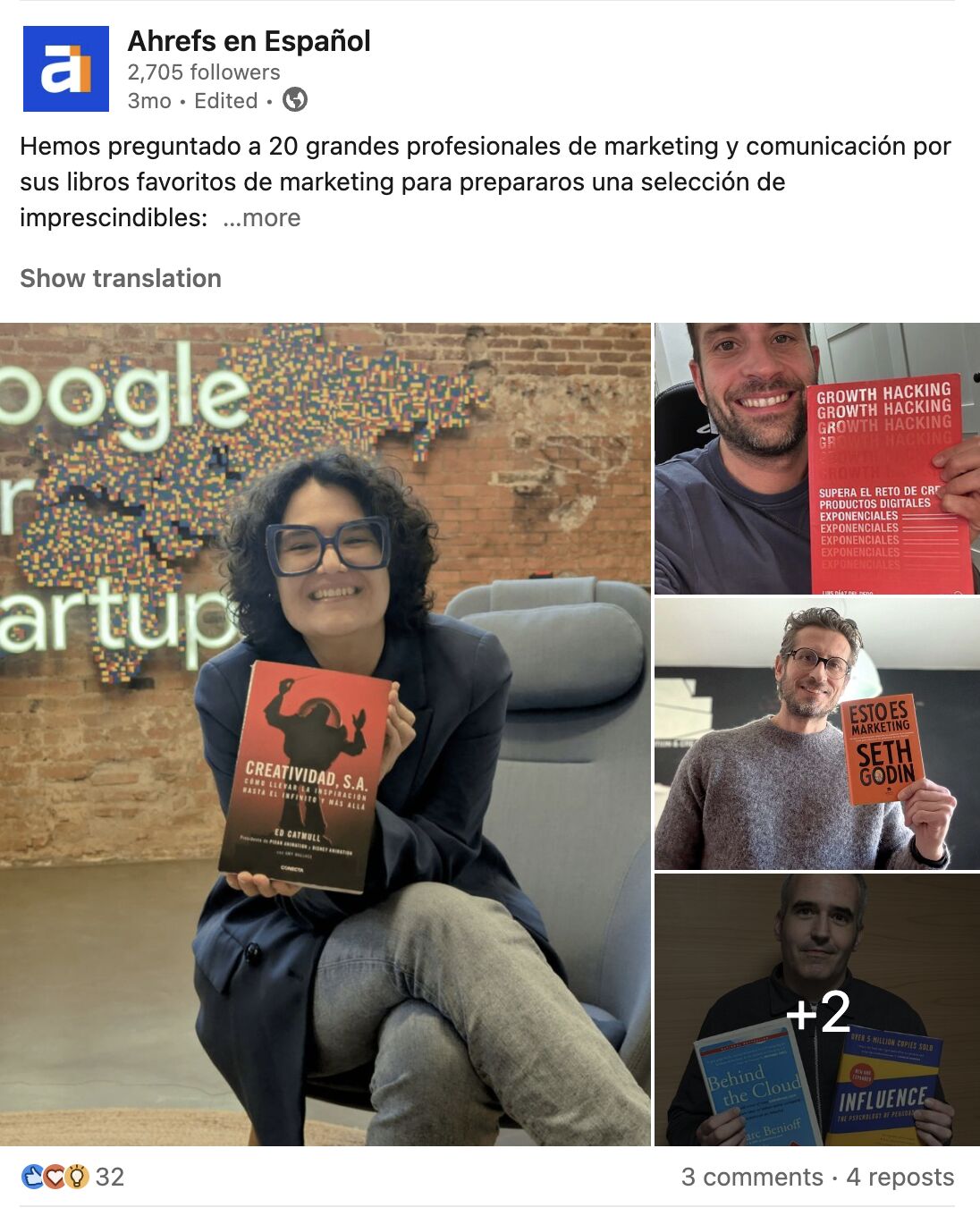
The results:
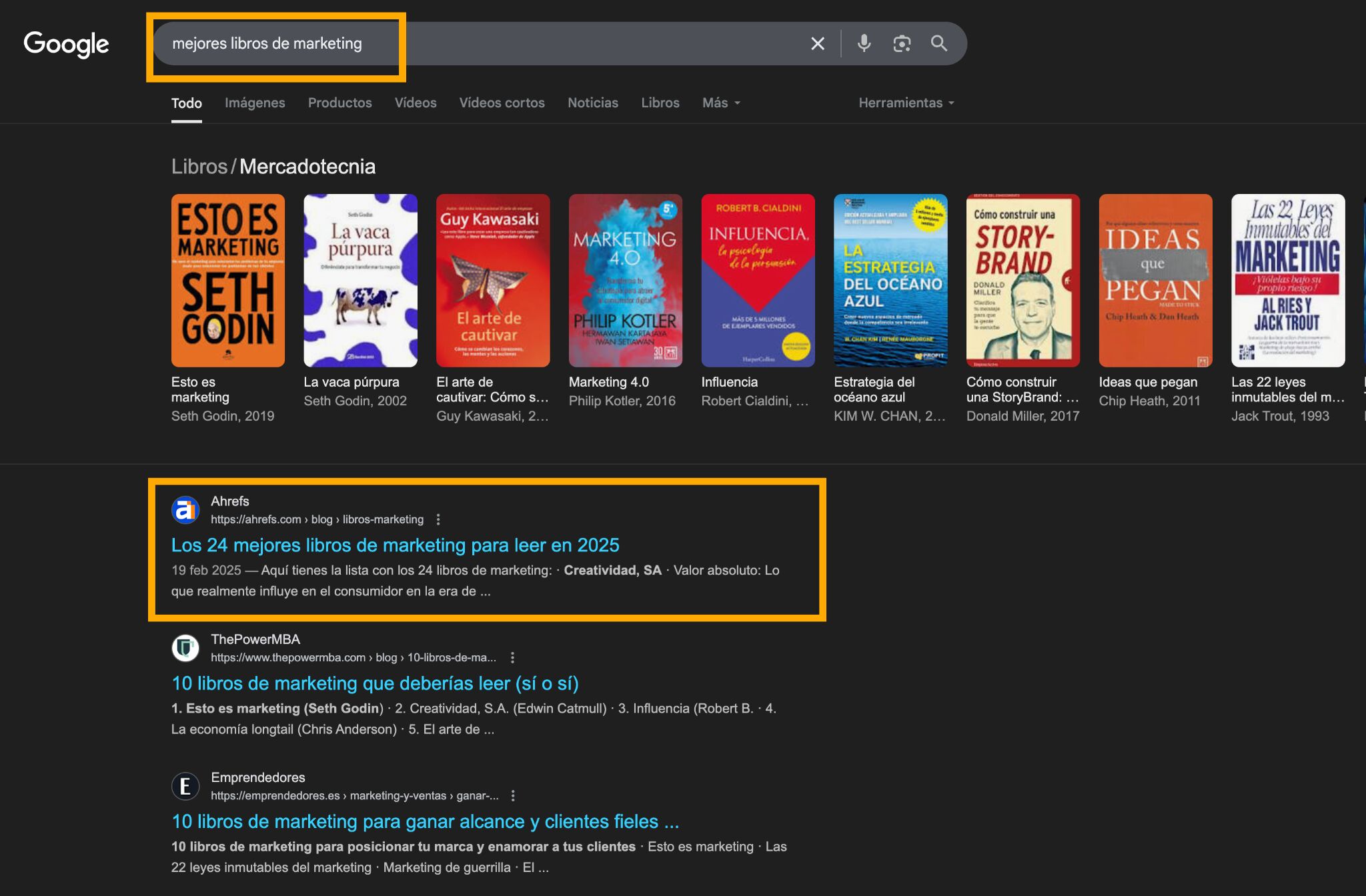
Erik’s team recently started using this approach in Japan as well. Here’s an example of a case study they created featuring a Japanese agency’s success with Ahrefs.
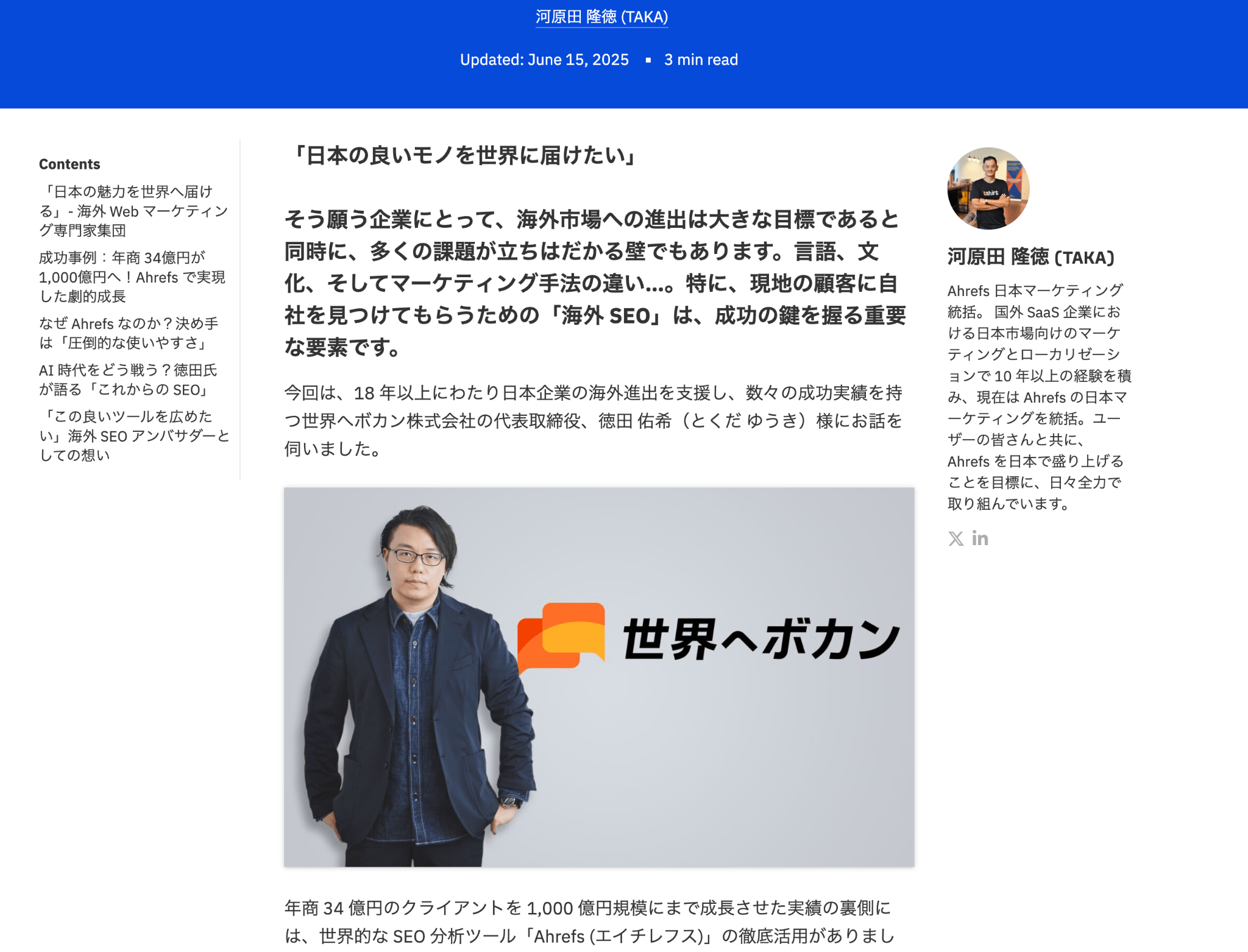
But content relevance isn’t just about using local examples; it’s also about voice and opinion. According to Erik:
“One day this will be fully replaced by AI, and what will matter will be opinionated content by local authors.”
Featuring local authors not only boosts authenticity but also social reach.
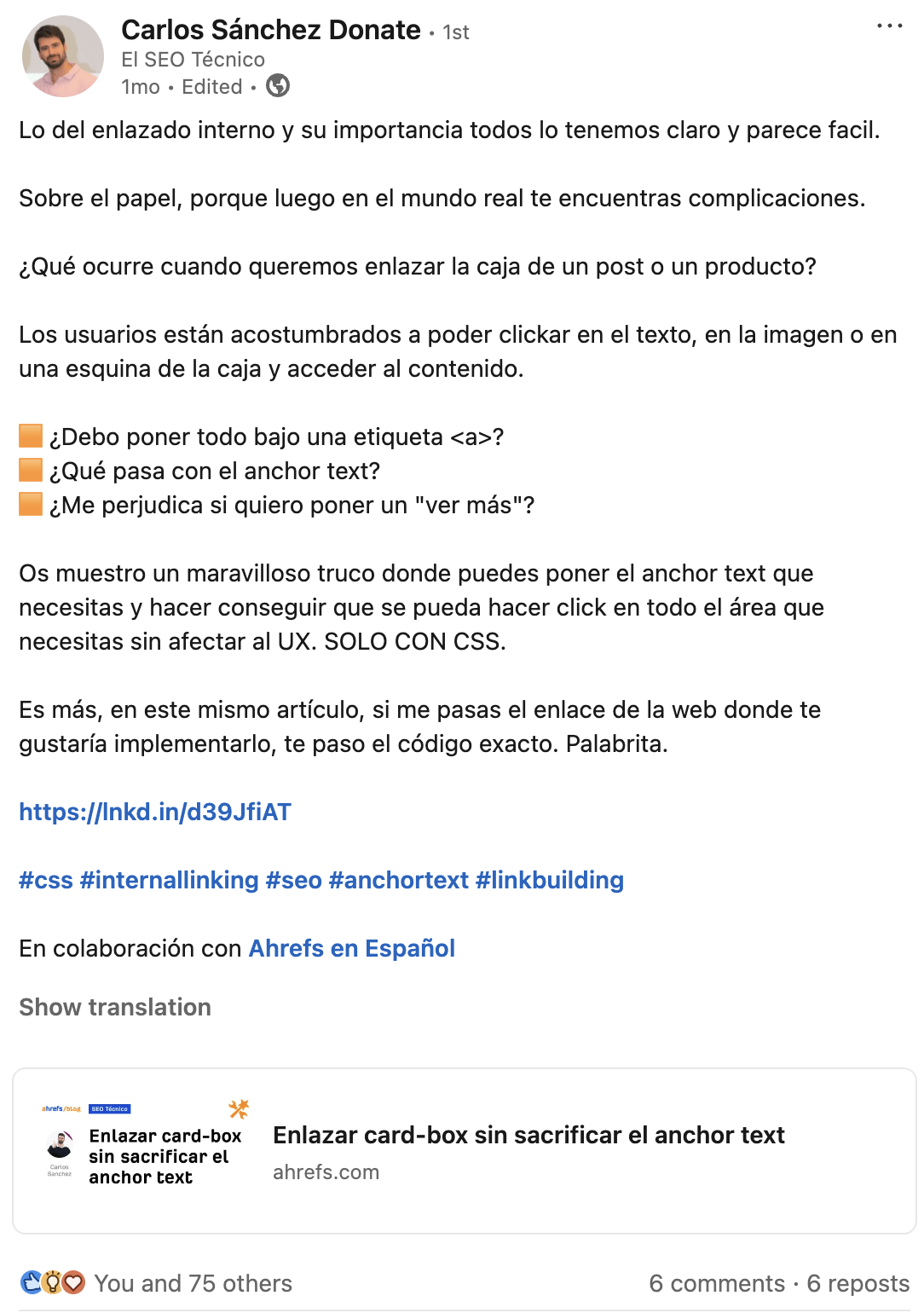
And here’s the bonus: content like this naturally earns links.
“We don’t follow any specific approach [to link building]. Those local links come naturally, and Site Explorer shows steady growth.”
When your blog content feels like it was created for the local audience—not just translated at them—it builds trust. That trust turns into shares, mentions, and backlinks. Invest in content quality and cultural connection. Local links will come, as you can see in the screenshot below.

Erik shared a case study showing how republishing articles can restore or even improve search performance, especially when rankings have plateaued or declined over time.
Search engines often favor freshness, and updating signals that your content is still relevant.
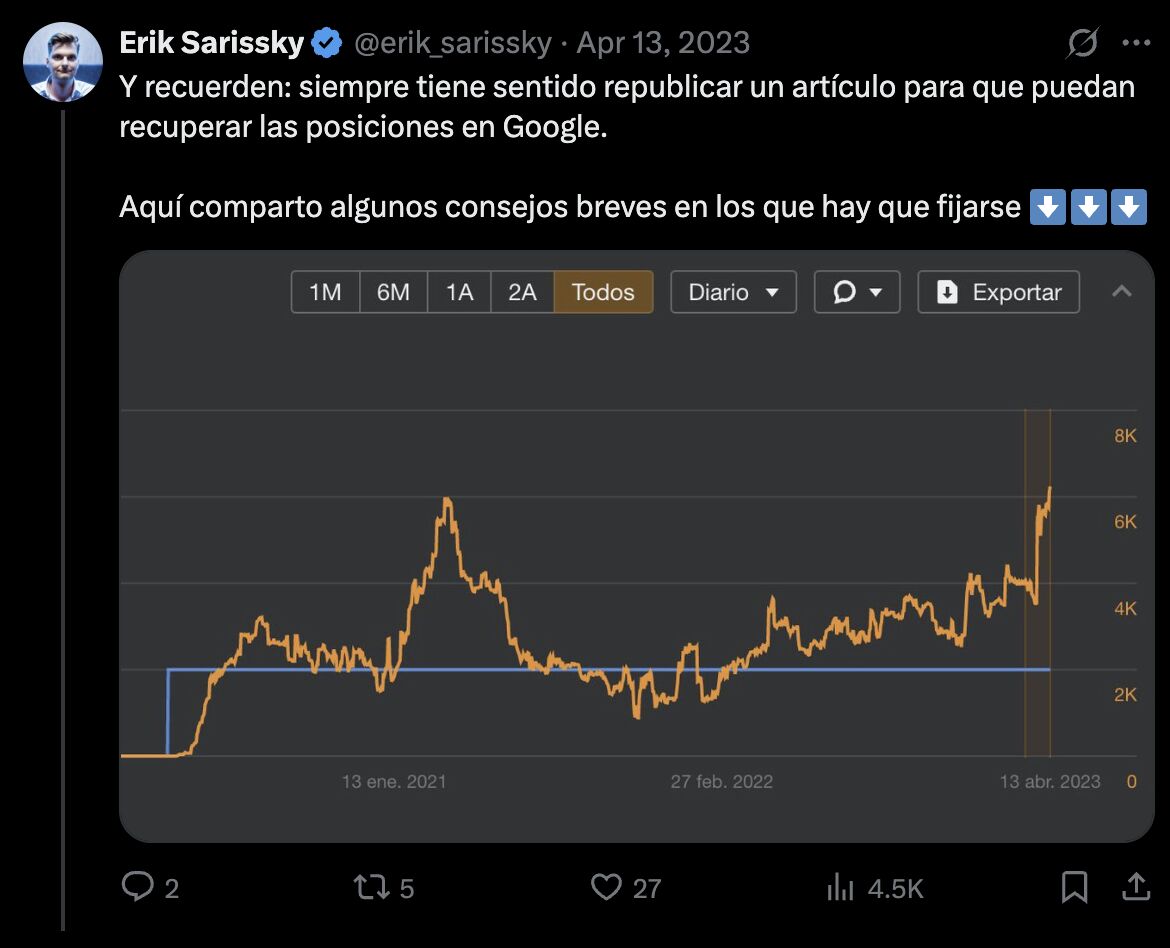
What to focus on when republishing:
- Update outdated information. Review stats, examples, screenshots, and links. Bringing everything up to date shows Google (and users) that the article is still relevant and trustworthy.
- Improve internal linking. Use Ahrefs’ internal link opportunities feature to connect your updated article to relevant content across your site. This helps distribute link equity and improves crawlability.
- Use People Also Ask as a content guide. Check Google’s “People Also Ask” section to find common related questions and add answers to your article. This makes it more comprehensive and aligned with search intent.
- Enhance with visuals and data. Add infographics, charts, or updated statistics to support your points. This makes content more engaging and can improve dwell time and backlink potential.
AI can speed up the basics, but it still stumbles on nuance. You’ll need humans to iron out the details.
We implemented an AI pre-translation system based on an established glossary, prompts, and translation memory, since AI has the capability to learn and self-improve.
He added:
“The [Spanish] Blog is run by humans for now, but we’re also testing AI pulling articles, translating them, and uploading to blogs.”
Start with automation where it helps most—bulk translation, glossary management. But always leave room for human QA.
You need editors who can spot layout glitches, catch broken links, and flag mistranslations or cultural mismatches that AI might miss. Build in clear feedback loops between translators, reviewers, and content owners to make sure quality improves with every iteration.
By the way, this applies to all types of content localization, including product UI. For example, we had a funny mistranslation in Ahrefs’ interface for quite some time. Instead of “don’t compare”, it said “don’t buy”.
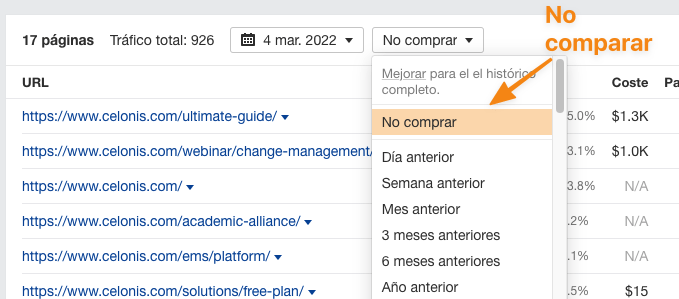
Style guides and glossaries are the most exciting, but they’re your best defense against inconsistency.
“Glossary, style guide, SOPs… that’s how we ensure consistency.”
This is also the perfect time to think more strategically and decide things like whether we want to translate product names and original concepts.
To maintain quality across languages, document everything. Create a shared glossary of key terms, establish tone and formatting rules, and build an editorial style guide that translators and local writers can rely on. Erik shared how both of those documents look for Ahrefs.
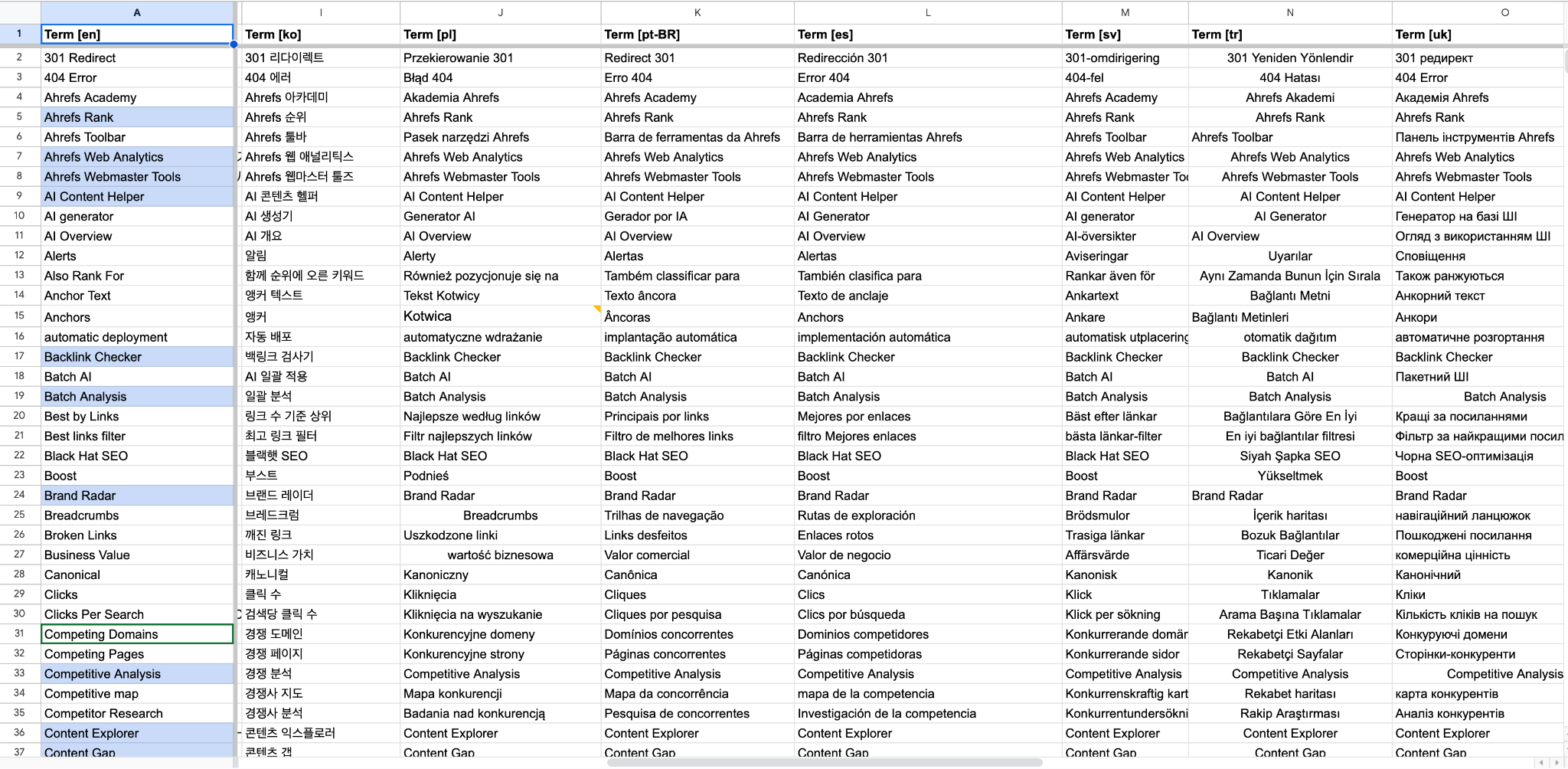
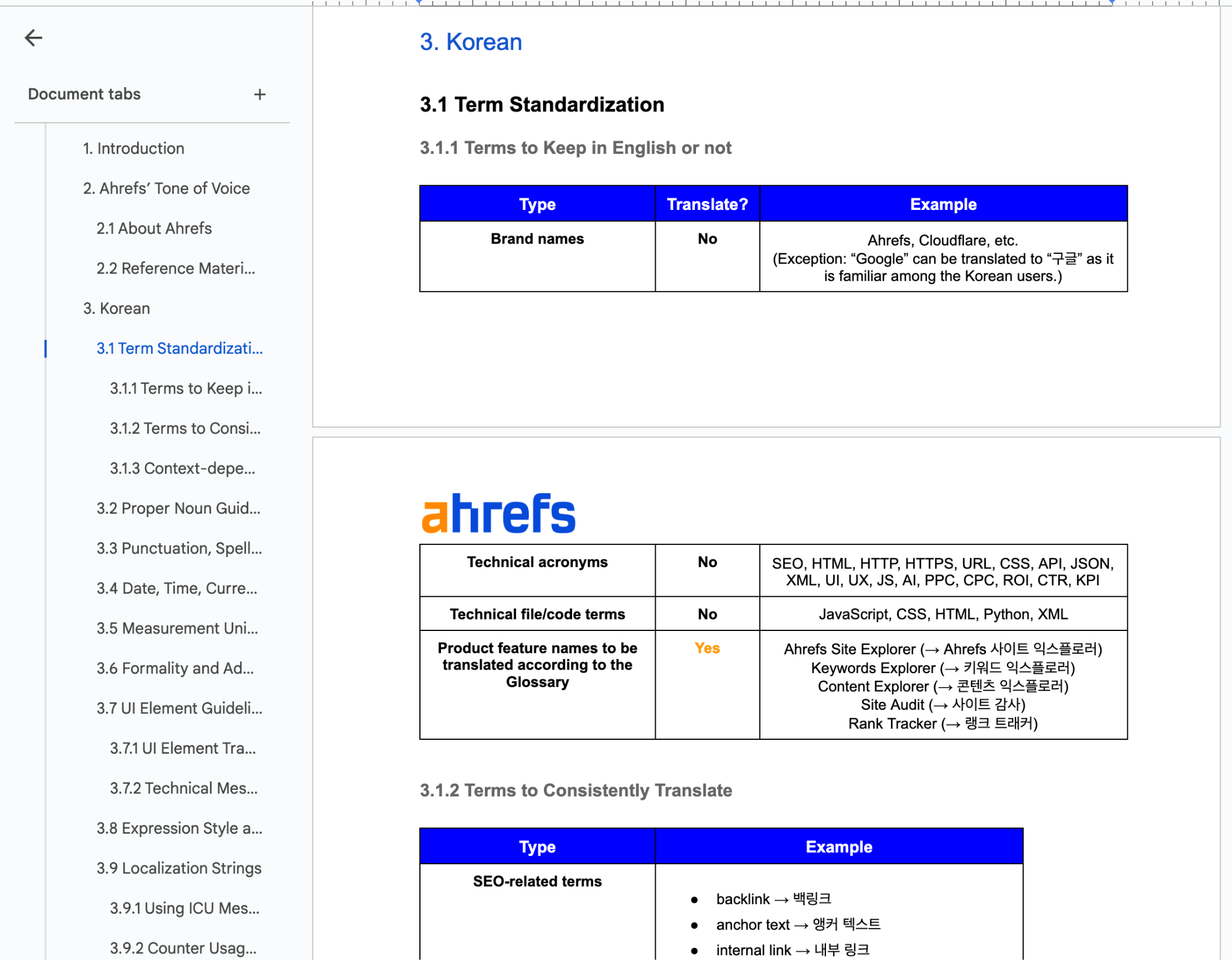
Keeping every version aligned with the source? That’s a major pain. But there’s hope.
Erik found a cool use case for the Content changes feature in Ahrefs’ Site Explorer (you can find it in the Overview report). If the English blog has made any changes to the content that resulted in more traffic, he’ll see exactly what it was. Then he can just repeat the same thing for localized versions.
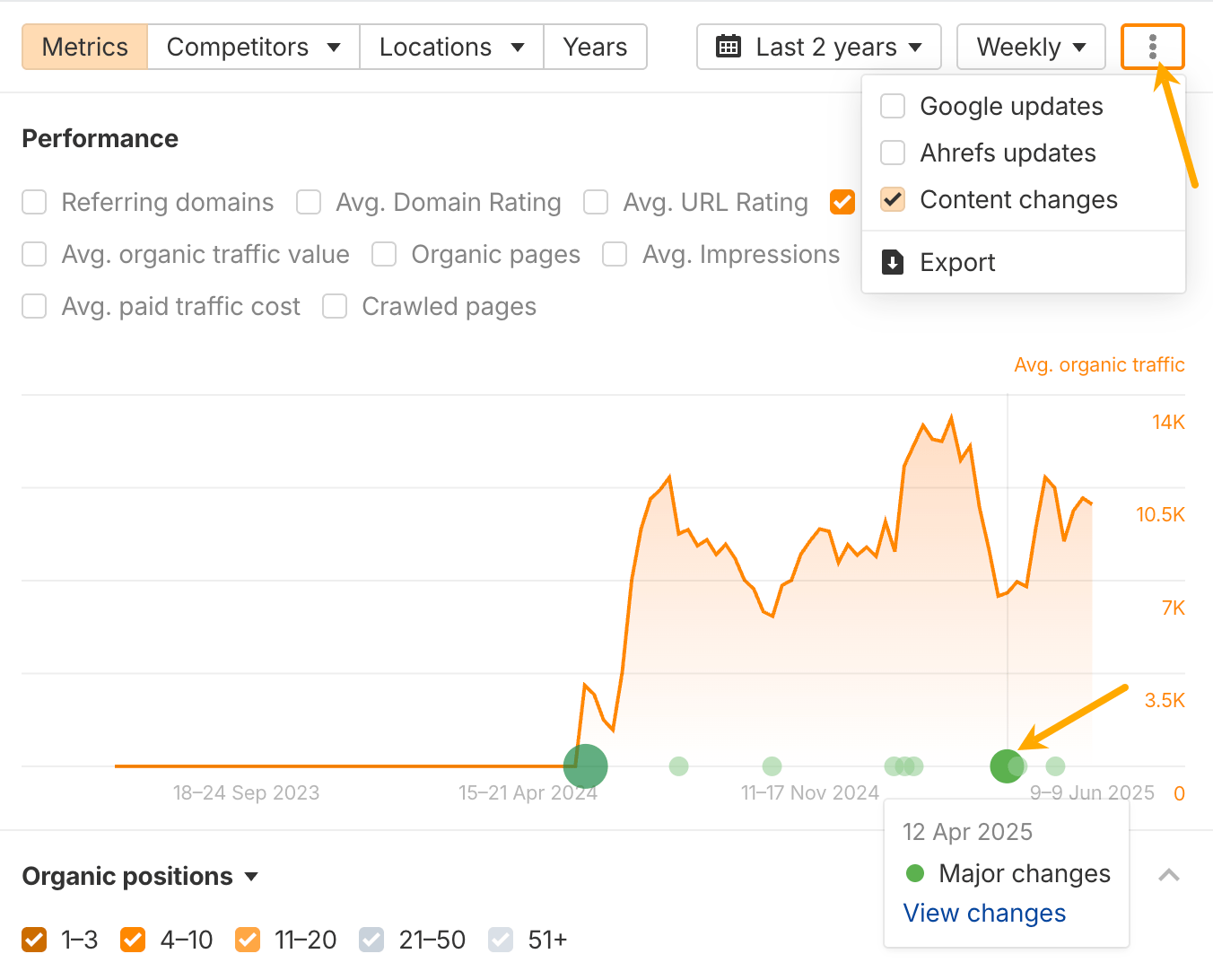
Behind every successful localization strategy is a solid technical foundation. That includes getting hreflang tags right, adjusting internal linking structures, and ensuring localized media files don’t break the user experience.
- Choose your URL structure wisely: Subfolders like “example.com/fr/” are typically better for SEO because they consolidate all your domain authority in one place. Country-code top-level domains (ccTLDs) like “example.fr” can feel more local and trustworthy to users in that country, but split your SEO efforts across multiple domains, making it harder to rank globally.
Don’t redirect users by IP: Automatically sending visitors to a localized version of your site based on their IP can confuse Googlebot, which crawls mostly from the US. That means your localized content might not even get indexed. Instead, show a language or region switcher so users can choose their preferred version without being forced to do so. - Consider a CDN: A content delivery network helps serve your website from servers closer to the user, which reduces loading times—especially important for international audiences. Fast deliver better user experiences and this counts for Google, so this small infrastructure change can have big performance impacts.
- Implement hreflang properly: The hreflang tag tells Google which version of your content is meant for which language or region. If it’s misconfigured, Google might serve the wrong version in search results. Ahrefs’ Site Audit tool helps you catch issues here by visually mapping your hreflang structure and flagging broken links between language versions.
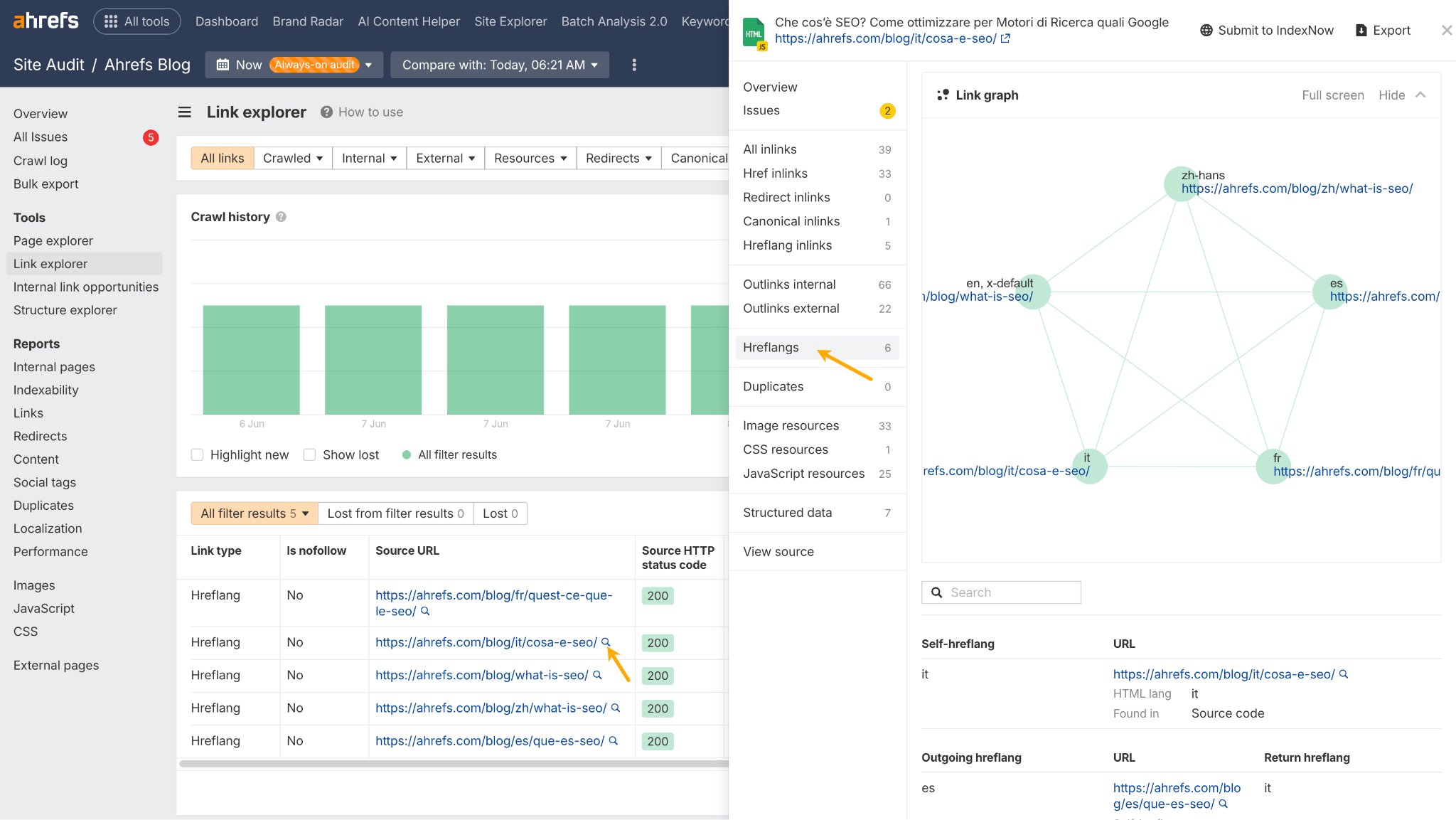
We’ve got a full guide on the technical aspects here: 10 International SEO Best Practices + Checklist.
Final thoughts
The best strategies are born from experience, especially mistakes.
“I wouldn’t redo anything, because if I didn’t try, I wouldn’t know. Basically, FAFO.”
Don’t aim for perfection from day one. Test. Learn. Adapt. Every market will teach you something new. Track what works, double down on wins, and let go of approaches that stall.
Got questions or comments? Let me know on LinkedIn.



